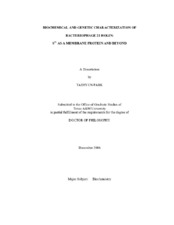| dc.description.abstract | The fate of phage-infected bacteria is determined by the holin, a small membrane
protein that triggers disruption of the membrane at a programmed time, allowing a
lysozyme to attack the cell wall. S2168, the holin of phage 21, has two transmembrane
domains (TMDs) with a predicted N-in, C-in topology. Surprisingly, TMD1 of S2168
was found to be dispensable for function, to behave as a SAR ("signal-anchor-release")
domain in exiting the membrane to the periplasm, and to engage in homotypic
interactions in the soluble phase. The departure of TMD1 from the bilayer coincides
with the lethal triggering of the holin and is accelerated by membrane depolarization.
Basic residues added at the N-terminus of S2168 prevent the escape of TMD1 to the
periplasm and block hole formation by TMD2. Lysis thus depends on dynamic topology,
in that removal of the inhibitory TMD1 from the bilayer frees TMD2 for programmed
formation of lethal membrane lesions. Like the holin S of λ, the holin of lambdoid phage
21 (S21) controls lysis by forming holes in the membrane. However, unlike Sλ, these
holes are small, serving only to depolarize the membrane facilitating the release and
activation of the SAR endolysin, R21. We were able to demonstrate that, unlike Sλ, S2168 forms a “pinhole”, thus macromolecules easily pass through Sλ but not S21 holes. This
result again supports our interpretation: when S21 triggers, it only needs to collapse the
membrane potential, thus causing release and activation of the membrane-tethered
inactive SAR endolysin, but does not form holes in the membrane large enough to allow
passage of a pre-folded, active cytoplasmic endolysin. The lysis defective S2168 mutant
alleles were isolated throughout the S21 gene. Although the majority of lysis defective
mutations occurred in the codons for the TMD2 domain, two mutations were found in
the codons for the TMD1. This result suggests that only the TMD2 domain of S2168 is
likely to participate in actual hole formation. One can assume that two mutant alleles of
TMD1 are involved in two different interactions: (a) TMD1-TMD1 intermolecular
interaction, (b) TMD1-TMD2 intramolecular interaction. We showed that there is a
specific TMD1-TMD2 interaction. In terms of TMD1-TMD2 interaction, the mutated
residues of the two TMD1 mutants might prevent a departure of TMD1 from TMD2,
resulting in the lysis defective phenotype. Hopefully, these findings deliver some hints
about the mechanism of S2168 hole formation and further provoke more extensive work
which is required to provide a definite answer to many questions regarding this matter. | en |


